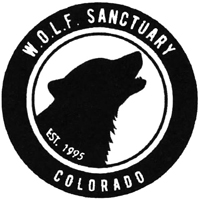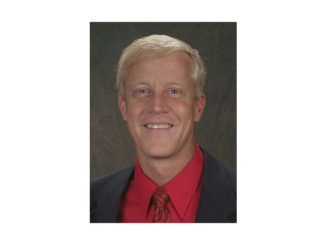 After a grueling, emotionally charged five and a half hour meeting, the Larimer County commissioners voted two to one to approve the Phase One of the W.O.L.F. project for a parcel of land to the north of 74E opposite Boy Scout Road on approximately 160 acres.
After a grueling, emotionally charged five and a half hour meeting, the Larimer County commissioners voted two to one to approve the Phase One of the W.O.L.F. project for a parcel of land to the north of 74E opposite Boy Scout Road on approximately 160 acres.
The acronym stands for Wolves offered Life and Friendship.
Present were Commissioner Lew Gaiter III, Commissioner Steve Johnson, Commissioner Tom Donnelly and Robert Helmick, Larimer County Senior Planner.
The courtroom was packed with a nearly equal number of those who supported the project and those who opposed it. Those in favor wore green and those opposed wore red and most sat on one side or the other, further illustrating a divided community. The issues of noise, specifically continuous howling, odor, the possibility of escape, the effect on wildlife and range animals were all to be addressed.
Shelly Coldiron began the staff presentation with a slide show addressing every conceivable situation. Rob Helmick has worked with the W.O.L.F. sanctuary evaluating the design of the facility from the county perspective. He has worked with the public as well, producing a 700 page document to address the issues.
The wolf in the wild is an animal to be feared, having been so to humans since the cave men had to compete with them for food. The pack is a complex social family, with older members (often the alpha male and alpha female) and subordinates, each having individual personality traits and roles within the pack. Packs defend their territory from invading packs by howling and scent marking with urine. The wolf can also be referred to as a cornerstone species, well demonstrated by the way their reintroduction to Yellowstone Park has restored the health of the ecosystem. They do this by killing and consuming other animals. Their reduction of the deer and elk population has reduced the overgrazing of willows and other vegetation important to riverbank structure and leaving the landscape vulnerable to erosion.
Some of the residents of the 74 E corridor might say “That’s just fine for Yellowstone but not in my backyard!”
The fear of wolves is a primal fear, a habit developed and retained over a millennia and ingrained deeply into the human psyche. But the animals housed at W.O.L.F. are not wolves. These are hybrids with no place to call home. They can’t hunt and would not survive in the wild. The only part of the wolf left in these animals is their howl.
The howling, from a distance, is an eerie sound, bringing to mind a fog filled scene in a gothic horror movie. Up close, the same sound becomes a sing along as formerly abused and neglected animals lift their snouts to the sky, celebrating their lives as creatures who are cared for and loved. The noise seems to be the main issue for the local residents, having moved to the mountains for peace and quiet and who Feel they will be forced to share the neighborhood with a kennel. The neighbors feel violated, imposed upon and considering the degree of tension the issue has created in the area, W.O.L.F. may always be a problem.
Ranchers are concerned for the well-being of their cows and insist the howling will be distressful to the livestock, enough so to cause the pregnant cows to abort their calves. Russell Prince a cattle technician, cited higher cortisol levels in cattle exposed to wolves. An internet search revealed that cattle will also respond negatively to industrial noise and traffic. The reintroduction of wolves to Yellowstone Park caused wolf migration to western states such as Montana, Oregon and Wyoming where there have been instances of wolves attacking and killing range cattle. The remaining cattle will show clear signs of stress after being exposed to wolf urine and howling. The following studies were performed in Oregon:
http://www.tsln.com/news/fight-or-flight-study,
Darlene Kobobel and Rick Silverberg from Divide, CO showed up in support of W.O.L.F. Darlene is the founder of Colorado Wolf and Wildlife in Divide and claims that the rancher’s concerns are exaggerated. She said her sanctuary is bordered by several ranches and the neighboring cattle have not been disturbed by the wolf howls. More information on her sanctuary can be found at: http://www.wolfeducation.org
There hasn’t been a wolf in Colorado since the 1940s and the animals in question are not wolves and not allowed to roam free. There are, however, bears, mountain lions, coyotes and bobcats that populate the area and do present a real threat.
Commissioner Gaiter III lives in Glacier View. When asked if he would allow the facility in his neighborhood he responded with a yes, since the wolf howls, like the coyotes, is a natural sound while the ATVs, chainsaws, gunshots, and logging trucks are not. He also stated that there had been a lot of good questions and interesting comments bringing up a fair amount of uncertainty and unknowns but, “None of us has a crystal ball.”
The site plan including both Phases 1 and 2 includes enclosures for up to 60 animals, plus an educational facility, housing for the volunteers and employees, a parking lot and a gift shop. They were hoping for 4 tours per day during the summer as part of Phase 2, which would likely not be initiated until 2020, at least. Phase 1 provides enclosures for the 30 animals already housed at the current site plus housing for volunteers and employees.
Commissioner Johnson summed up the 5 1/2 hour meeting in his closing speech proposing the commissioners vote on the approval of Phase 1. Commissioner Gaiter III stated that to the best of their ability, W.O.L.F. had gone out of their way to address the concerns of the public. The vote ended the meeting with Commissioners Johnson and Gaiter III in favor and Commissioner Tom Donnelly opposed.
The opposition is starting the process of appealing the decision. The conflict is not over yet. One major issue not getting enough attention is that if W.O.L.F. is forced to sell the property, it is likely to be sold to a developer. As it is, with Phase 1 of the property having been approved, 88% of the property will remain undeveloped. The 74 E corridor is already stretched to the limit as far as natural resources, one of these being water.
The questions for this divided community are:
Can the area support another development?
or
Will the W.O.L.F. sanctuary live up to its promises?
Support Northern Colorado Journalism
Show your support for North Forty News by helping us produce more content. It's a kind and simple gesture that will help us continue to bring more content to you.
BONUS - Donors get a link in their receipt to sign up for our once-per-week instant text messaging alert. Get your e-copy of North Forty News the moment it is released!
Click to Donate


